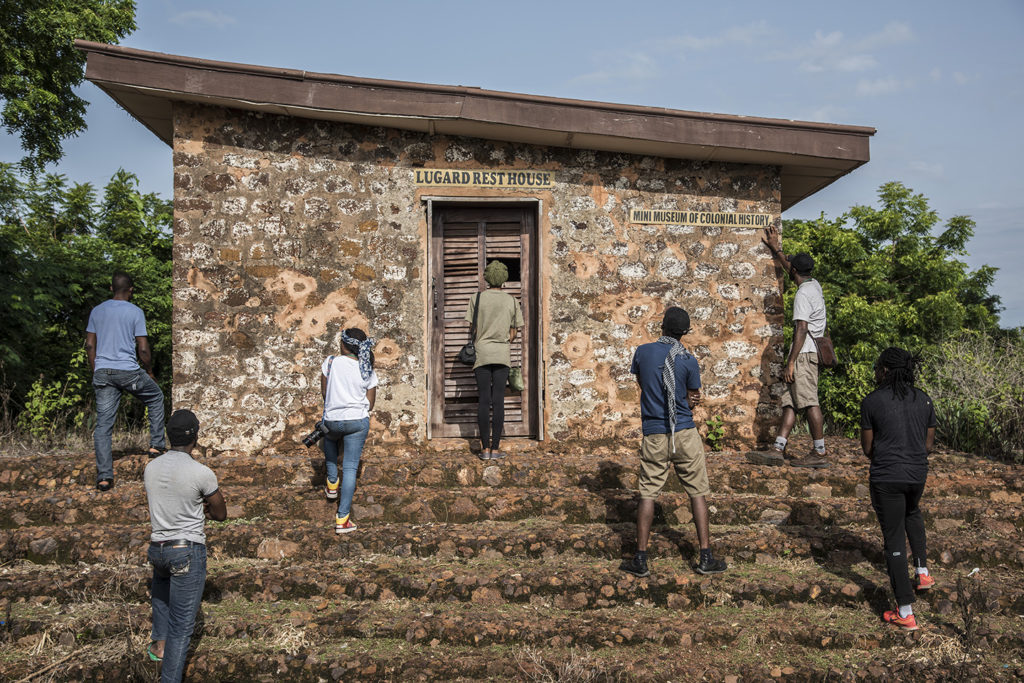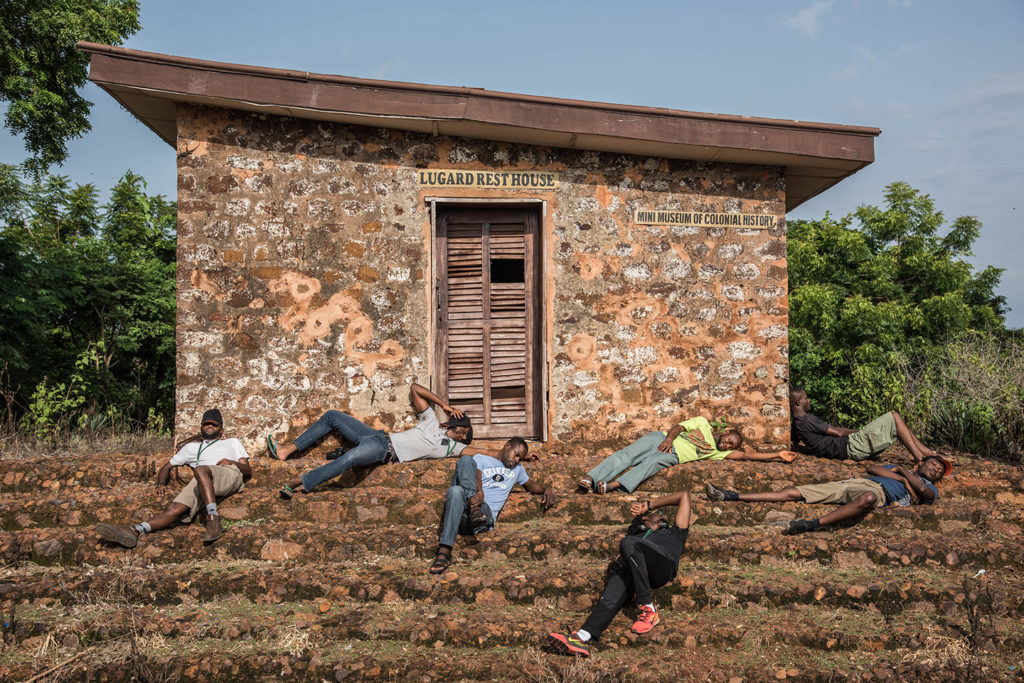THE GLOBALIZED MUSEUM?
DECANONIZATION AS METHOD: A REFLECTION IN THREE ACTS
BONAVENTURE SOH BEJENG NDIKUNG

Emeka Okereke, Lugard’s Rest House I, Lokoja, Nigeria, 2016.
© Emeka Okereke. Courtesy: Invisible Borders Trans-African Project
No one took seriously that flight of fancy. And things continued as before, with men binding female feet until they turned into something like the hooves of goats. For over a thousand years, until well into the twentieth century, the canons of beauty would not allow a girl’s foot to grow. The first version of Cinderella, written in ninth-century China, gave literary form to the male fetish for the diminutive female foot, and at the same time, give or take a year, the custom of binding daughters’ feet from infancy took root. It was about more than aesthetic ideals. Bound feet also bind: they were shields of virtue.
– Eduardo Galeano, Mirrors. Stories of Almost Everyone, 2009
I
Every few years, the “art world” seems to recognize that it has some deficits and shortcomings—that it is not so perfect after all. In an effort to close some of its most evident potholes, efforts are made to integrate other voices within the otherwise very exclusive circles that make up this “art world.” In the past forty years or so, the most frequent recurring finding has been that most of our museums, especially in the West but also beyond, are accommodated and commandeered by white men—dead and alive. Thus the recurrent outcry that we need to do something to change the situation.
This “something” has in the past decades meant various efforts to “diversify.” At various points the issue at stake was gender, as museums were forced to notice that women, though a majority on our planet Earth, were a rarity in their institutions. Then came the realization that most of our museum ideologies were carved around heteronormativity, and the institutions were challenged to consider LGBT communities and discourses as part of their infrastructures. The racial turn was lurking in the air, too, as Western museums were made to realize that little space in their collections and programs was allocated to indigenous, black, or other nonwhite artists and communities of African, Asian, or Latin American backgrounds. Now, the global turn—an effort that has kept museums in the United States, England, and France on their toes for the past decade as they strive to open up toward other geographies—seems to be spreading its tentacles into Germany. Before getting granular on what the “global” in the global museum turn might mean, it is worth considering a few qualms regarding such efforts, however well-intentioned they may be.
Looking at most efforts to “diversify” the museum in particular and the “art world” at large in regard to gender, race, class, geography, and sexuality, one notices that very few such initiatives are intrinsic. More often than not, they are initiated and championed by either funding bodies or governmental apparatuses, according to their more or less transparent cultural and political agendas. This is not per se a negative thing, but three questions are worth considering here. First, if one looks at the bigger picture, what political or cultural agendas are guiding such initiatives? Second, do the museums that take part in such projects have a genuine interest in diversifying their collections and programs, as well as questioning the canonical artworks and discourses that prevail within their institutions? Or is the fact of guaranteed funding the bigger bait that enables participation, but does not result in substantial engagement in pursuing this interest in diversification post-funding? Third, how can one explain that very few museum institutions think of the intersectionality of race, gender, class, geography, and sexuality when it comes to diversifying their programs and collections, but rather focus on one of the aforementioned before proceeding to another?
All of these questions would require in-depth cogitation, which this short essay can hardly provide, but painting ahead with a broad brush, the following observations should be taken into account. A careful observer will note that projects that aim at diversification of museums, whether because of time, knowledge, interest, or facility constraints, tend to be more symbolic than true investigations into how this opening-up might be profound and sustainable. In most cases, as soon as the funding is over, it’s back to business as usual. The diversification also leans toward tokenism, as a few well-known women, indigenous, LGBT, or PoC artists are dropped into the scenario at hand to fulfill the stipulated goals. Opening one canon to another canon is never a revolution.
One often hears of a museum’s claim of doing its “Africa show,” “Arab show,” or something of the sort as an effort toward diversification. Beyond the usual arguments of ghettoization, it is also legitimate to question the intent and objectives of such exhibitions when for example an “African show” is done, and then in the next years no artist of African origin is ever invited to participate in a show at that same museum. Or when in such projects there is little engagement with the local context and communities, let alone engagement that takes into consideration shared colonial histories.
If initiatives of diversification of museum collections and programs are to be serious and taken seriously, institutions have to go the extra mile to implement the three Ps: the diversification must be reflected in their projects, their publics, and their personnel. How can we get past the stereotypes of white men producing knowledge for or about PoC, indigenous people, women, LGBT individuals, or people from other geographical spaces without inviting them to the table of decision making, nor developing a diverse audience? And speaking of sustainable structures, it doesn’t suffice to invite one black woman or LGBT person to a panel, internship, or residency; rather, it’s necessary to engage in long-term exchanges from within. Only then can one really claim diversification in general or a global museum in particular.

Emeka Okereke, Lugard’s Rest House II, Lokoja, Nigeria, 2016.
© Emeka Okereke. Courtesy: Invisible Borders Trans-African Project
II
In this second act, we’ll begin with a brief consideration of the concept of the global. Though often taken for granted, the global as perceived from the vantage point of geography relates to the whole world, promises internationality and universality, and contrasts these with the national or the local. In a recent interview, asked about the global and the local, the Caribbean poet Vladimir Lucien said:
“I don’t see the local and the universal in conflict with each other. Some of the greatest works of literature were very provincial. They have lasted through time and transcended the context from which they originated. There’s a claim you can make for internationalism, but how well do we know the world as something other than an abstraction? For me, the world is too capacious a place to inhabit, and I think a poet ought to inhabit a place. The chief mechanism of a poem has to be vision and vision has to be connected with people and sharing in their fate.”(1)
The issue at stake: Where is the local, especially in this postcolonial era and context, in the crafting of the concept of the global museum? And this local cannot be simplified, but analyzed as a complexity that goes beyond national or racial categories, and that takes into consideration historical and geographical entanglements as much as geopolitical and social intricacies.
The global relates to or encompasses concepts of wholeness—claims of completeness, of comprehensiveness, of being encyclopedic, of universalism. This is crucial when one considers how knowledge has been produced and disseminated over the past centuries, especially within the colonial enterprise. The universalization of Western knowledge systems, languages, and understanding of the arts, culture, science, and religion played an important role in the power gradient established between the colonizer and the colonized.
How does the global museum position itself within or without this long and omnipresent history of epistemicides (to invoke Boaventura de Sousa Santos), if the global were to mean universalism?(2)
At any rate, one needs to consider issues of cooptation when one deals with the global. The global too might imply gross generalizations. There is the risk of over-reduction and over-flattening if everything is seen through a particular prism. Which is to say, if the world is seen only through the eyes of the Western canon, as is the case when Forough Farrokhzad is called Iran’s Sylvia Plath or Wifredo Lam is called the Cuban Picasso, then the global poetry or the global museum can be of no benefit.(3)
But one must acknowledge too the very thin lines between the adjective global, the verb globalized, and the noun globalization. Those thin lines are characterized by capitalist (often neoliberal) economic and political structures. “The globalized world” connotes a development that makes international influence and operations possible through often-unbalanced relations, and globalization has become synonymous with the processes through which businesses, governments, and nongovernmental organizations alike strategize, develop, and conquer international markets, and the social and political spheres, with profound and lasting implications.
In Fear of Small Numbers: Globalization and Its Negative Sides, Arjun Appadurai proposes that one can hardly reduce globalization to other concepts in history such as capitalism, imperialism, neocolonialism, modernization, or developmentalism. To Appadurai globalization is all of these, and it is even further sophisticated and accessorized with some new elements, namely speculative financial capital, the power of electronic information technology as part of new financial instruments, and new forms of wealth generated by electronic finance markets. The question is then how the global museum situates itself within this trajectory in an age of museum self-aggrandizement through expansions, speculations, and franchising.
In “Museums and Globalization” (2005) Saloni Mathur describes the new mega-museum that aspires to be always bigger and better than the last, like the Getty Center in Los Angeles, the Guggenheim in Bilbao, or Tate Modern in London.(4) These mega-museums that consider themselves global are central urban (re)developments in particular places in the world, with their megalomaniacal architectural structures. They are also central in certain cultural propagations, as they introduce to their spaces, geographies, and historical contexts a certain canon framed in these institutions of power. Mathur’s essay describes how museums are suffering from an identity crisis, as they are perched precariously at the financial brink while over-marketing their collections and sacrificing their institutional integrity, having been contaminated by the circuits of capitalism. The obvious example she offers is what she calls the McGuggenheim effect, a system of franchising chiefly implemented by Thomas Krens, former director of the Guggenheim. In the 1990s he championed the expansion of the institution as a project he called the “global Guggenheim,” which involved erecting new branches in Berlin, Las Vegas, Bilbao, and Abu Dhabi; he pursued further projects in Brazil, Russia, and China. The Louvre, the Centre Pompidou, and others have followed suit. Would this be the model for the global museum?
III
Every society develops its canon. And it is fair to say that no canon is superior to another and none can or should supersede another, as canons are formed in the wake of particular historical and social givens or myths. But it is also fair to acknowledge that canons, just like History with a capital H, are epistemic, cultural, political, and social power tools, whose mechanisms have to be scrutinized and critically questioned. Does making the museum global just mean a conglomeration of various canons from around the world, and therefore a togetherness and juxtaposition of power structures? Indeed, the canons of both the West and the East have one thing in common: they were constructed and maintained by men. As Eduardo Galeano points out, the beauty canon established and promoted by Chinese men made the binding of female feet a beauty ideal, but what they actually had in mind was how to tame, control, and subjugate women.(5) The more destroyed your feet, the less likely you are to run away. Let’s think about high heels, too.
This process of radically questioning the power mechanisms that made and maintain canons is the first step of what I would like to call “decanonization as method.”
In “Musical Canonization and Decanonization in the Twentieth Century” (2013), Anne C. Shreffler points to the traditionalist Carl Dahlhaus, who defended the legitimacy of the European canon on the basis of the authority of tradition by arguing that “the musical canon is ultimately unaffected by subjective matters such as taste and preference (whether our own or those of past actors), but rather is shaped by larger historical forces. Historians are not in a position to create or even alter the canon; they must reckon with what has been presented to them by tradition.”(6) In contrast Shreffler points to a more critical voice, Joseph Kerman, who in 1983 posed the ever-so-relevant question “How are canons determined, why and on what authority?”(7) Shreffler observes that Kerman’s question shows that the canon is constructed in ways that are visible and identifiable, rather than simply “given,” and that “even if tradition’s inner workings are hard to pin down, there must be an authoritative instance behind any canon that exerts the force that enables it to be formed and to remain over time; these instances can be unmasked, and their inner workings revealed.”(8)
This seems to be the task that lies ahead of us all. Decanonization is that possibility of unmasking and revealing the inner workings of the canon—whether from the West, East, North, or South. Decanonization is the possibility of making the canon more elastic by bringing in works from indigenous people, PoC, LGBT people, and those from “other” geographies, and not seeing these new additions only through the eyes of the works that already inhabit the canon. We must entertain the possibility of reviewing, rejecting, and declassifying some works that were thought to have been canonized. An ultimately flexible and elastic canon is akin to a non-canon.
Decanonization involves dismantling the hierarchical structures that produce canons, and a striving to eliminate the emergence of parallel canons. Needless to say, “the canon” as synonymous with “the Western canon” is currently redundant. So if museums are to be spaces of knowledge creation, conservation, and propagation, they must grow with their times. Their programs and collections must reflect historical positions that are susceptible to correction, just as much as their programs and collections must reflect issues that touch a nerve in the present and give a hint of the future. Museums must be sensible to the power gradients that reign through exclusion, for anything that is built on exclusion and limited knowledge cannot be a reference point.
Decanonization as method must be understood in the sense of both the destabilization of existing canons and the stunting of the growth of new ones. Decanonization is de-erasure—that is, the ability to make reappear, rewrite, rearticulate, and rephrase what was erased, not in relation or reaction to an existing canon, but in relation to relevant topics, themes, and subjects. Decanonization is a flux or flexibility of the rank and file, a situation in which no one is here to stay and all are at any time possible, depending on the social, political, economic, and ethical issues at stake.
Decanonization is not limiting museums to certain national, geographical, gender, or race questions, but constantly working at the points where all of those intersect. Decanonization is when hierarchies are put in question, when the normalized modes of knowledge production and dissemination are challenged, when the usual ways of object and subject displays and modes of view are defied. Decanonization is when knowledge is performed, and when the objects in museums are instigated to be part of performances rather than treated as relics or residues of times, spaces, or epistemologies past. Decanonization as method is choosing embodied practices as mediums and formats of discourse and knowledge, delinking from the conventional referencing phenomena and proposing a more phenomenological approach of dealing with histories, memories, cultures, sciences, religions, and knowledges at large.
The proposal of decanonization as method is thus a proposal for what might be a global museum of self-reflexivity, whereby the idea will not be to create new or parallel canons, or place them side by side, or universalize the Western canon, but to decanonize the entire notion of the canon.
Bonaventure Soh Bejeng Ndikung is curator at large, documenta 14; artistic director, SAVVY Contemporary, Berlin; and editor in chief, SAVVY Journal.
Originally published in Mousse 58 (April–May 2017)
1. Nandini Majumdar, “Digging with My Pen: A Conversation with Saint Lucian Poet Vladimir Lucien,” The Wire(India), February 4, 2017, https://thewire.in/105242/digging-with-my-pen-conversation-with-saint-lucian-poet-vladimir-lucien/.
2. Boaventura de Sousa Santos, Epistemologies of the South: Justice against Epistemicide (Paris: Paradigm, 2014).
3. For instance https://www.theguardian.com/books/2017/feb/12/forough-farrokhzad-iranian-poet-ebrahim-golestan-slyvia-plath;
http://www.telegraph.co.uk/art/what-to-see/wifredo-lam-the-unlikely-comeback-of-the-cuban-picasso/.
4. Saloni Mathur, “Museums and Globalization,” Anthropological Quarterly 78, no. 3 (2005).
5. Eduardo Galeano, Mirrors: Stories of Almost Everyone (New York: Nation Books, 2009).
6. Carl Dahlhaus, Grundlagen der Musikgeschichte (Cologne: Wilhelm Fink, 1977), author’s translation.
7. Joseph Kerman, “A Few Canonic Variations,” Critical Inquiry 10, no. 1 (1983), quoted in Anne C. Shreffler, “Musical Canonization and Decanonization”
8. Ibid., 8.

